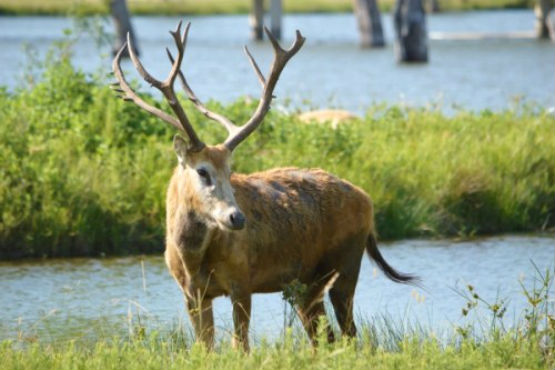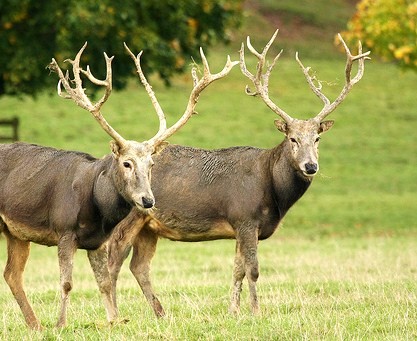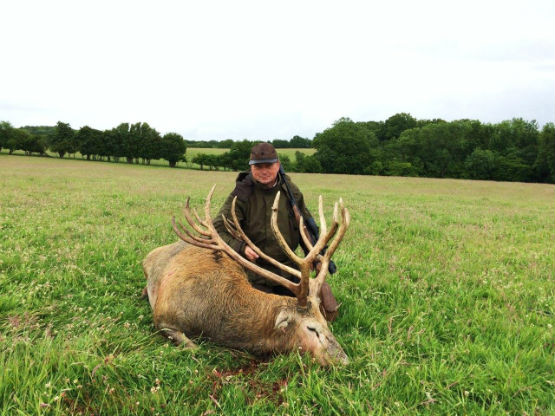Pere David Deer Hunting - Toby Worthington looks at the history of the lesser Known Père David Deer and its extraordinary journey from avoiding extinction to becoming a much admired UK Park Deer Species.

(Above: The Pere David is in fact semiaquatic and is native to the subtropics of China)
Over 4000 years ago and according to Chinese legend, a Horse a Donkey an Ox and a Deer went deep into the forest to meditate on the actions of a wicked King. They each contemplated on the barbaric acts of the ruler and became determined to jointly rectify his wrong doing. Upon awakening from their trance, they transformed themselves into just one animal and galloped to the Kunlun Mountains to seek counsel from the Primeval Lord of Heaven.
So amazed by the amalgamation of this weird creature, that had antlers of a deer, hooves of an Ox, face of a Horse and tail of a Donkey the great Lord exclaimed “It is unlike any of four creatures” and named the animal ‘sibuxiang’ meaning four not alike. The great Lord blessed the animal and gifted it to his disciple Jiang Ziya who rode the sibuxiang to victory over the evil King who subsequently founded the Zhou dynasty.
It’s a beautiful story that has entered into Chinese mythology and captures some of the wonder of this most unusual animal. Today the Sibuxiang is currently known as ‘Pere David’s Deer ‘after its discovery by French Missionary Armand David in China in 1866. Armand David (Pere David) sent a carcass to Paris for examination whereupon it first became known to Western science.
 In fact it is a miracle that Pere David’s Deer survived at all. In its native country China, the deer was hunted to near extinction, with only a few animals maintained in the Royal Hunting Grounds. In 1895 a huge flood drowned many of the remaining animals and reduced the walls of the Royal Hunting grounds to rubble. Those deer that escaped the Royal gardens were slaughtered by starving local peasants for food and the deer that remained in the park were subsequently shot by troops during the Boxer Rebellion in 1900.
In fact it is a miracle that Pere David’s Deer survived at all. In its native country China, the deer was hunted to near extinction, with only a few animals maintained in the Royal Hunting Grounds. In 1895 a huge flood drowned many of the remaining animals and reduced the walls of the Royal Hunting grounds to rubble. Those deer that escaped the Royal gardens were slaughtered by starving local peasants for food and the deer that remained in the park were subsequently shot by troops during the Boxer Rebellion in 1900.
(Above: The Pere David is also commonly known as the 'Milu' or 'Elaphure')
This could have been a tragic end to a beautiful and unusual species, however as fortune has it, it was again the historic Woburn Abbey that played a crucial role in the survival of this species. Numerous European parks had over the years illegally had specimens transported from China. It was from these collections that the 11th Duke of Bedford Herband Russell was able to nurture a large and successful herd from which the ‘Milu' or Elaphure' as it is also known, was again able to be introduced to China in 1985.
Today Pere David’s Deer is doing well amongst various private collections in the UK. Unlike several other species of deer introduced to Woburn Abbey, there have been no successful releases into the wild. This of course means that the Pere David is not considered amongst the UK’s six species of deer.
The Pere David is indeed a strange looking beast, I myself have found their appearance to be like no other deer species. The antlers themselves can best be described as resembling tree branches whilst the weight and size of these animals is significantly larger than any of our UK’’s native species.
For those that have stalked all of the UK’s six deer species and want something a little different, there is no doubt that the Pere David can potentially offer an exciting stalk and a very unique trophy.
(Above: A superb Trophy taken with County Deer Stalking. The financial returns invested in stalking these magnificent beasts continue to insure its ongoing survival and financial viability)
The stalking is of course confined to various Deer parks in which the Pere David have long since dwelt, parks which have essentially been responsible for saving this magnificent animal from extinction.
If you would like more details about hunting and stalking Pere David's Deer in the UK, contact County Deer Stalking:



















